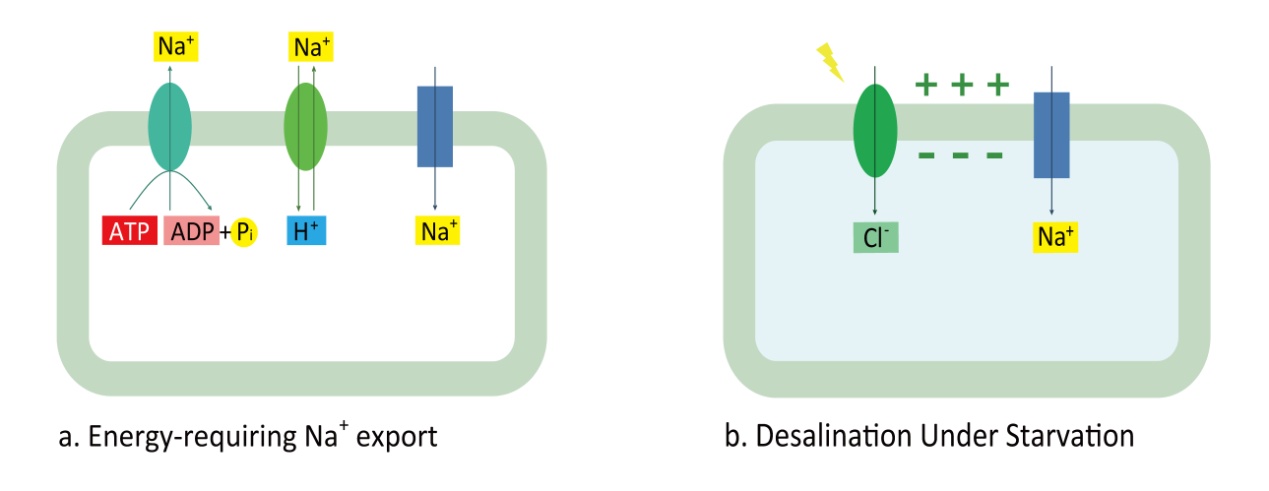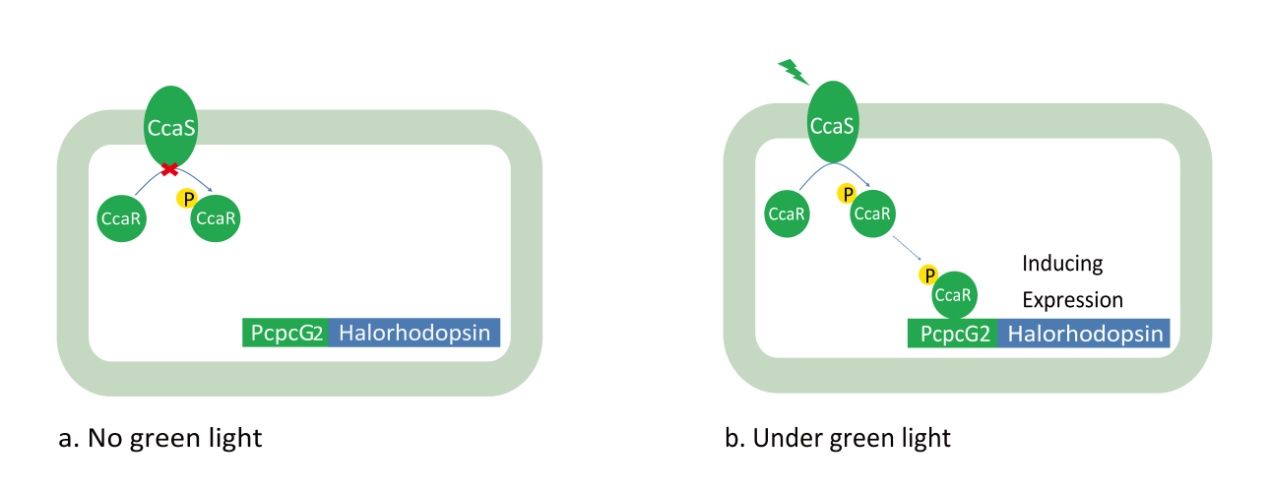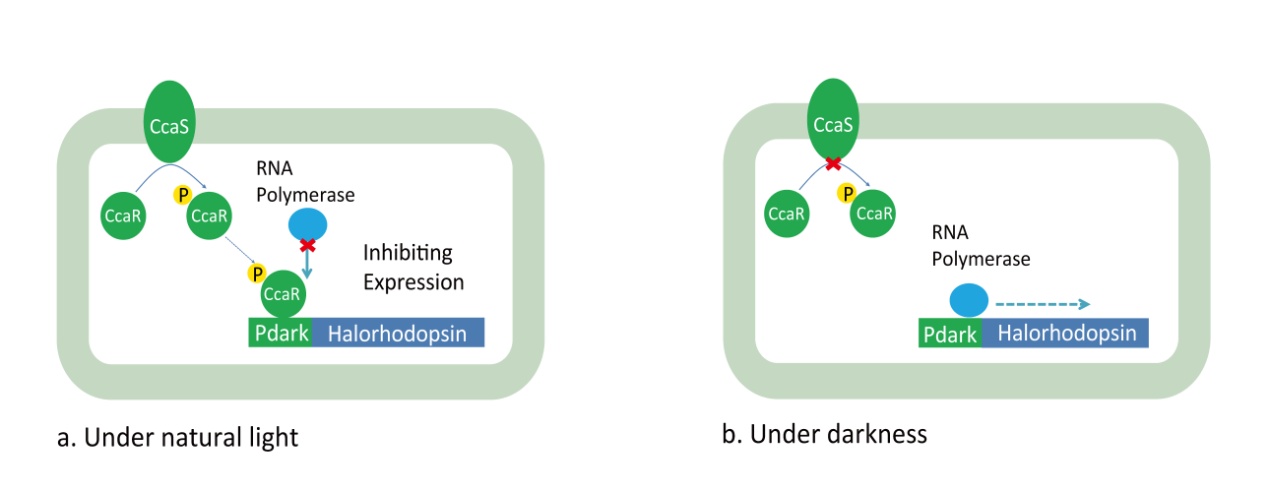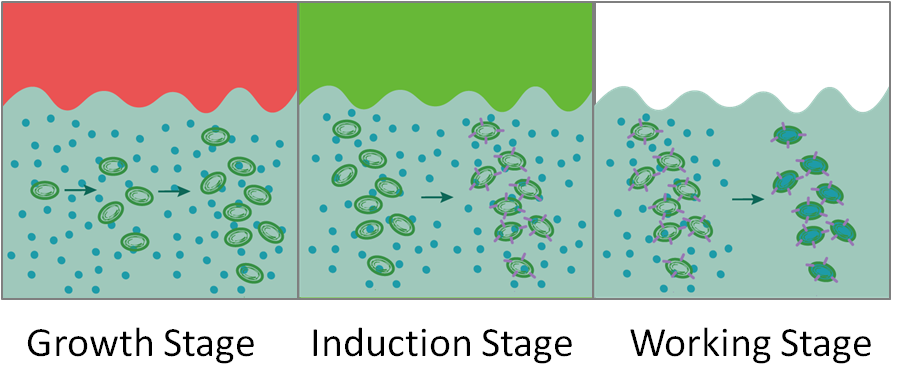Design
Contents
Design of transport module
Halorhodopsin (HR) proteins are light-driven inward-directed chloride pumps from halobacteria. They are membrane-integral proteins of the rhodopsin superfamily that form a covalent bond with the carotenoid-derived chromophore all-trans retinal. Absorption of a photon with a defined optimal wavelength induces trans-cis isomerization of retinal, which triggers a catalytic photocycle of conformational changes in the protein, resulting in the net import of one chloride per photon into the cytoplasm. (Amezaga,J.M.et al.2014) We use it as our biodesalination driver which confers cyanobacteria the ability to absorb chloride to a significant degree.
As for sodium, cyanobacteria can actively export sodium ion to maintain low internal sodium concentration under saline environment. And this is mainly performed by Na+/H+ antiporter and P-type Na+ ATPase; the former one requires H+ gradient as the energy source and the latter one consumes ATP directly. Since the ATP synthase is driven by H+ gradient, we can simply regard that ATP is required for active Na+ export. And the ATP requirement provides opportunity to halt sodium export by depleting internal ATP stores. Manipulation of cultivation conditions such as omitting photosynthetically efficient wavelengths from the light spectrum will may deplete nutrient supply and exhaust ATP reserves. Moreover, we propose that the negative membrane potential generated by halorhodopsin would drive the influx of cation through sodium ion channels.
Figure 1.2.1 Design of transport module.
(a) Cyanobacteria actively export Na+ by Na+/H+ antiporter(green oval) and P-type Na+ ATPase (blue-green oval) to resist Na+ flowing inside through Na+ channels(Blue box) under saline environment.
(b) Under starvation, ATP reserve has been exhausted and Na+ flow through Na+ channels, which is driven by the negative membrane potential generated by halorhodopsin (green oval).
In summary, the halorhodpsin drives Cl- inside, thus generating negative membrane potential, which will drive import of Na+ given that starvation inhibits active Na+ export. This design of transport module is shown in Figure 1.2.1 .
Design of control system
——PcpcG2 and Pdark
Light-inducible and heavy metal inducible promoters are the main biological switches in synthetic biology of cyanobacteria. Considering that our ultimate goal is to obtain an engineered organism capable of extracting sodium chloride from seawater without leaving any harmful substance, candidate promoters should meet a few key criteria. Firstly, the inducing condition shouldn’t leave any harmful substance that is difficult to remove. Secondly, the inducing condition shouldn’t cost too much if applied to industrial scale. Thirdly, the inducing condition should be compatible with starvation. Based on these conditions, we selected two light-inducible promoters which are described in the following paragraphs.The control of PcpcG2 over downstream gene is based on the CcaS-CcaR-PcpcG2 system identified in PCC 6803, which has been characterized and further engineered to be a useful genetic tool. (Abe, K. et al. 2014) The phycobilisome linker gene cpcG2 is chromatically regulated by the sensor histidine kinase CcaS and cognate response regulater CcaR. CcaS catalyzes antophosphorylation followed by phototransfer to CcaR under green light[4]. Phosphorylated CcaR binds to PcpcG2 and induces expression of cpcG2, or halorhodopsin in our recombinant strain. The control mechanism is seen in Figure 1.2.2.
Figure 1.2.2 Control mechanism of PcpcG2.
(a) Without green light, unphosphorylated CcaR can’t bind to PcpcG2 and significant level of halorhodopsin can’t be achieved.
(b) Under green light, phosphorylated CcaR binds to PcpcG2 and induces expression of halorhodopsin.
Red light and green light require artificial illumination or extensive light filter, which may cause difficulty in scaling up biodesalination process. We searched for another promote that allows the process to rely only on natural light and darkness. And Pdark, which is from previous iGEM team (BBa_K1026009), was our answer. This “dark-sensing” promoter combines PcpcG2 and a constitutive promoter from Ecoli and it can be regarded as the “reverse PcpcG2”. Pdark contains binding site of CcaR in PcpcG2, which overlaps with the binding site of RNA polymerase. Therefore the binding of RNA polymerase to Pdark will be blocked and transcription can’t be initiated when phosphorylated CcaR binds to it. The control mechanism of Pdark is seen in Figure 1.2.3.
Figure 1.2.3 Control mechanism of Pdark.
(a) Under natural light, the green light component induces phosphorylation of CcaR, and the binding of it to Pdark prevent the binding of RNA polymerase, thus inhibiting expression of halorhodopsin.
(b) Under darkness, RNA Polymerase normally binds to Pdark and initiate the transcription of halorhodopsin.
Design of biodesalination process
The cultivation of engineered cyanobacteria comprises three phases: growth phase, Induction phase and desalination phase. After cyanobacteria reaching a high density, we induce the expression of halorhodopsin, and subsequently we move the cyanobacteria into white-light condition afterwards, which allows the halorhodopsin to work.
Based on PcpcG2 and HR, we established a biodesalination system which relies on red and green light. The light colors in the three stages are red light, green light and white light respectively. In the growth stage, red light is enough for photosynthesis of cyanobacteria and we determined the curve under red light (seen in the Experiment and Results section). In the Induction stage, the green light induces the expression of HR. Additionally, green light can’t provide energy source for chlorophyll, thus creating a starvation condition. In the working stage, halorhodopsin absorbs light to drive chloride import. The biodesalination process controlled by PcpcG2 is shown in Figure 1.2.4.
Figure 1.2.4 Biodesalination process controlled by PcpcG2.
In the growth Stage, cyanobacteria absorb energy from red light and grow to a certain density; In the induction stage, green-light induces the expression of halorhodopsin, and additionally pushes cyanobacteria to starvation status; In the working stage, engineered cyanobacteria absorb sodium chloride under natural light.
Based on Pdark and HR, we constructed an improved biodesalination system which depends only on the switch between white light and darkness. In the growth stage and working stage, we provide white light while in the induced expression stage we remove the light source. The biodesalination process controlled by Pdark is shown in Figure 1.2.5.
Figure 1.2.5 Biodesalination process controlled by Pdark.
In the growth Stage, cyanobacteria grow to a certain density; In the induction stage, darkness induces the expression of halorhodopsin, and additionally pushes cyanobacteria to starvation status; In the working stage, engineered cyanobacteria absorb sodium chloride under natural light.
It can be predicted that the working stage can’t be too long because cyanobacteria will regain energy under natural light. Considering this, we can extend this process by alternating induction stage and working stage to achieve more reduction of salinity. Moreover, if the Induction stage and working stage are approximately 12h, after growth stage this improved biodesalination system can be controlled by the normal alternation between day and night without any human intervention.
Reference
Abe, K., Miyake, K., Nakamura, M., Kojima, K., Ferri, S., Ikebukuro, K., & Sode, K. (2014). Engineering of a green‐light inducible gene expression system in Synechocystis sp. PCC6803. Microbial biotechnology, 7(2), 177-183. Amezaga, J. M., Amtmann, A., Biggs, C. A., Bond, T., Gandy, C. J., Honsbein, A., & Templeton, M. R. (2014). Biodesalination: a case study for applications of photosynthetic bacteria in water treatment. Plant physiology, 164(4), 1661-1676.










